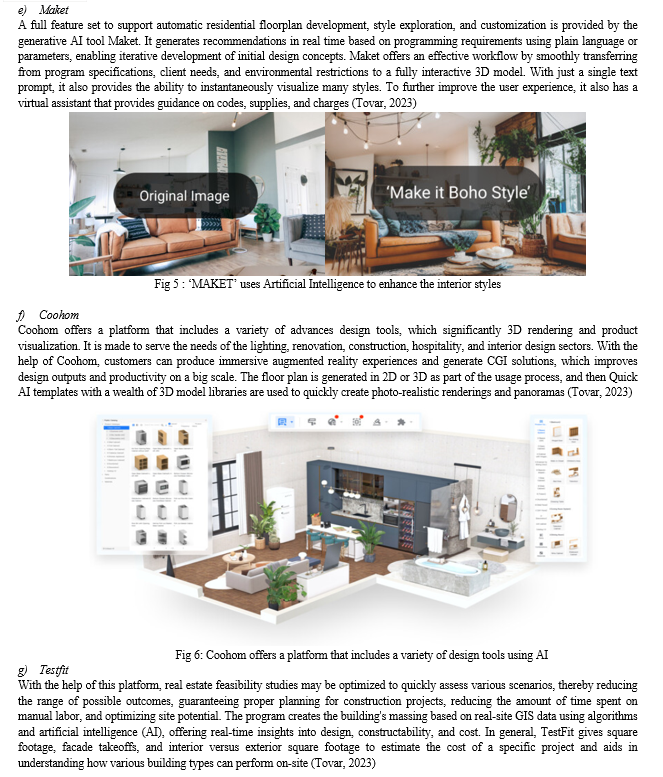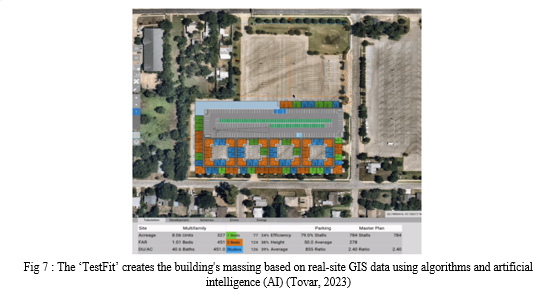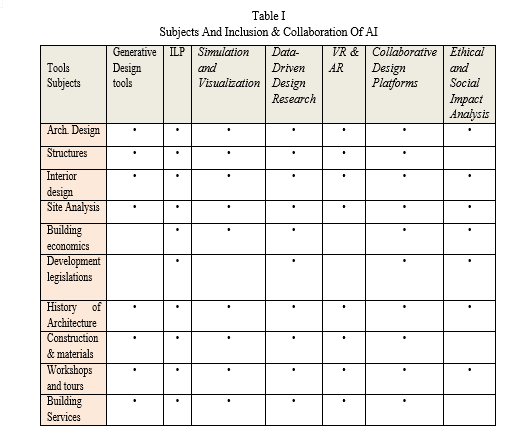Ijraset Journal For Research in Applied Science and Engineering Technology
- Home / Ijraset
- On This Page
- Abstract
- Introduction
- Conclusion
- References
- Copyright
Paradigm Shift in Architectural Pedagogy incorporating Artificial Intelligence
Authors: Dr. Mohit Kumar Agarwal
DOI Link: https://doi.org/10.22214/ijraset.2024.60055
Certificate: View Certificate
Abstract
The paradigm shift in architectural pedagogy encompasses various facets, each contributing to a holistic transformation of the educational landscape. From computational design methodologies to generative algorithms, AI empowers students to explore a vast array of design possibilities, pushing the boundaries of creativity and problem-solving. The goal of this study is to understand the paradigm shifts in the constantly changing fields of architectural education with the incorporation of Artificial Intelligence (AI). This change transforms architectural teaching fundamentally in addition to redefining architectural practice approaches. Now that we are at the crossroads of technology innovation and human creativity, it is critical to investigate how artificial intelligence (AI) might transform architecture education and promote creativity, sustainability, and adaptation. The primary exploration reveals a significant gap in the current teaching methods, with little emphasis on AI. The study emphasizes the urgency of incorporating certain approaches into architectural education along with AI which would enhance learning experience of the students.
Introduction
I. INTRODUCTION
The paradigm shift in architectural pedagogy encompasses various facets, each contributing to a holistic transformation of the educational landscape. From computational design methodologies to generative algorithms, AI empowers students to explore a vast array of design possibilities, pushing the boundaries of creativity and problem-solving. Moreover, AI-driven simulations facilitate real-time feedback, allowing students to iterate and refine their designs with precision and efficiency.
Moreover, AI is being used in architecture education in ways other than design processes. It includes urban planning techniques, building performance optimization, and sustainability research. Students may gain a better knowledge of how their designs affect the environment and investigate creative ways to lessen these effects by utilizing AI-driven data analytics. The incorporation of AI promotes critical thinking and multidisciplinary teamwork in addition to technical abilities. Students are encouraged to challenge accepted wisdom and investigate cutting-edge methods of practicing architecture as they interact with AI technology. Additionally, interdisciplinary engagement with data science, computer science, and engineering specialists enhances the educational experience by promoting an innovative and diverse thinking culture.
Notwithstanding the enthusiasm surrounding AI in architecture education, it is imperative to confront possible obstacles and ethical deliberations. As artificial intelligence (AI) grows more pervasive in architectural practice, concerns about algorithmic bias, data privacy, and the value of human judgment are becoming more pressing. Teachers have to work through these issues and help pupils develop a sense of accountability and ethical awareness.
II. LITERATURE SURVEY
A. Expert Views on changing Pedagogical approaches in Architecture with AI
Experts in the field of architecture have offered insights into how AI is changing pedagogical approaches in architectural education. The computational design and architectural education, emphasizes the transformative potential of AI in architectural pedagogy which advocates for integrating AI-driven generative design tools into design studios to empower students with new modes of exploration and creativity (Terzidis, 2023).
Research in computational design and robotic fabrication, emphasizes the need for architectural education to adapt to the capabilities of AI and advanced technologies and advocates for a pedagogical approach that combines hands-on experimentation with computational methods, enabling students to leverage AI as a tool for design exploration and innovation (A. Menges, 2011)
Dr. Sabin, known for her work at the intersection of architecture, biology, and computation, emphasizes the importance of AI in expanding the scope of architectural education. She advocates for a pedagogical approach that embraces AI-driven simulation tools and data-driven design methodologies, enabling students to explore complex systems and emergent phenomena in architectural design (Sabin, 2014). Dr. Rahm, a practicing architect and educator, emphasizes the need for architectural education to prepare students for the interdisciplinary challenges of the future. He advocates for a pedagogical approach that integrates AI with other fields such as ecology, sociology, and urbanism, enabling students to develop holistic design strategies that address pressing societal and environmental issues (Krstic, 2015).
Dr. Leach, a scholar of architectural theory and digital design, highlights the ethical implications of AI in architectural education. He advocates for a critical examination of the biases embedded within AI algorithms and their impact on design decision-making. He encourages educators to foster a dialogue around the ethical use of AI and its implications for architectural practice (Schulman, 2023)
B. A.Pedagogical approaches for providing Theoretical Knowledge in architectural subjects
Providing theoretical knowledge in architectural subjects requires a variety of pedagogical approaches to engage students and facilitate deep understanding. Mentioned here are some of the effective approaches:
- Lecture-Based Teaching: Traditional lectures can be used to introduce key concepts, historical contexts, and theoretical frameworks. However, it's important to keep lectures interactive by incorporating multimedia presentations, real-world examples, and opportunities for questions and discussions.
- Case Studies: Analyzing case studies of notable architectural projects allows students to understand theoretical concepts in context. They can examine the design process, cultural influences, technical considerations, and the social impact of architectural interventions.
- Socratic Method: Engage students in critical thinking and active participation through the Socratic Method. Encourage them to ask questions, explore different perspectives, and articulate their ideas through dialogue and debate.
- Design Studios: Design studios provide a hands-on approach to learning where students can apply theoretical knowledge to practical design projects. Incorporate design charrettes, critiques, and collaborative exercises to foster creativity and problem-solving skills.
- Field Trips and Site Visits: Take students on field trips to architectural landmarks, museums, construction sites, and urban environments. This experiential learning allows them to observe architectural principles in practice and understand the built environment in context.
- Guest Lectures and Workshops: Invite practicing architects, urban planners, historians, and theorists to deliver guest lectures and conduct workshops. Their real-world experience and expertise can provide valuable insights and inspire students to explore diverse perspectives.
- Research Projects: Assign research projects that require students to investigate specific architectural theories, movements, or practitioners in depth. Encourage them to critically evaluate primary sources, scholarly literature, and contemporary debates in the field.
- Digital Tools and Visualization: Integrate digital tools such as computer-aided design (CAD), Building Information Modeling (BIM), and architectural visualization software into the curriculum. These tools enable students to explore complex ideas, simulate design scenarios, and communicate their concepts effectively.
- Interdisciplinary Collaboration: Encourage interdisciplinary collaboration by partnering with departments such as urban studies, sociology, anthropology, environmental science, and engineering. This interdisciplinary approach fosters holistic understanding and prepares students to address complex challenges in architectural practice.
- Peer Learning and Group Projects: Foster peer learning and collaboration through group projects where students work together to research, analyze, and present architectural topics. This collaborative learning environment promotes teamwork, communication skills, and peer feedback (Salama, 2014) (Ayse T. Ertuna, 2016) (Federico Wulff Barreiro, 2018) (Ozlem Akinci, 2019)
C. Pedagogical approaches for providing Practical Knowledge in architectural subjects
Providing practical knowledge in architectural subjects requires a combination of pedagogical approaches that engage students in hands-on learning experiences.
Here are some effective methods:
- Studio-Based Learning: Design studios are the cornerstone of architectural education where students engage in hands-on design projects under the guidance of experienced faculty members. Studio projects allow students to apply theoretical knowledge to real-world design problems, develop technical skills, and explore creative solutions
- Design-Build Projects: Design-build projects involve students in the entire process of designing and constructing a building or structure. These projects provide valuable hands-on experience in construction techniques, material selection, project management, and collaboration with stakeholders.
- Site Visits and Field Trips: Organize site visits to construction sites, architectural landmarks, and urban environments to expose students to real-world examples of architectural principles in practice. Field trips provide opportunities for observation, analysis, and hands-on exploration of built environments.
- Hands-On Workshops and Fabrication Labs: Set up fabrication labs equipped with tools and equipment for model-making, prototyping, and digital fabrication. Hands-on workshops allow students to experiment with different materials, construction methods, and fabrication techniques, fostering a deeper understanding of architectural concepts.
- Internships and Professional Practice: Encourage students to participate in internships or co-op programs with architectural firms, construction companies, or related industries. Internships provide valuable practical experience, exposure to professional workflows, and networking opportunities within the industry.
- Collaborative Projects and Team-Based Learning: Assign collaborative projects that require students to work in teams to solve complex design problems. Team-based learning promotes collaboration, communication, and peer-to-peer knowledge sharing, simulating the interdisciplinary nature of architectural practice.
- Simulation and Virtual Reality: Utilize simulation tools and virtual reality technologies to create immersive learning environments for architectural design and construction. Virtual simulations allow students to visualize building designs, explore spatial relationships, and experience construction sequences in a virtual setting.
- Case Studies and Problem-Based Learning: Analyze case studies of architectural projects to understand the design process, technical challenges, and decision-making strategies involved. Problem-based learning approaches present students with real-world design problems to solve collaboratively, encouraging critical thinking and creative problem-solving skills.
- Critique and Peer Review: Incorporate regular critiques and peer reviews into studio sessions to provide feedback on students' design work. Critiques encourage reflection, self-assessment, and constructive criticism, helping students refine their design solutions and improve their practical skills.
- Reflective Practice and Portfolio Development: Encourage students to engage in reflective practice by documenting their design process, reflecting on their experiences, and compiling a portfolio of their work. Portfolio development allows students to showcase their practical skills, design thinking abilities, and professional growth over time (Ipek Gursel Dino, 2016) (Mohd Fairuz Shahidan, 2012) (Larkin, 2013) (Margot McDonald, 2016)
D. Present day approaches in architectural pedagogy with the inclusion of AI
Integrating AI into architectural education can offer innovative pedagogical approaches that enhance learning outcomes and prepare students for the evolving demands of the profession in the present scenario. Here are several ways AI can be incorporated into architectural education:
1. Generative Design Tools:
AI-powered generative design tools enable students to explore a wide range of design possibilities efficiently. These tools can analyze parameters and constraints to generate numerous design alternatives, allowing students to focus on creative exploration rather than manual iteration.
Some examples of generative are as follows:
a) Hypar
Hypar is a cloud-based platform for generative design that facilitates the creation of product systems, building designs, and construction schedules by design teams. This platform generates suggestions by seamlessly integrating several building systems. It has tools for analysis and simulation to forecast and maximize performance. Furthermore, it aids in decision-making by means of an established procedure of creative tactics that gradually improve architectural concepts.
Hypar also incorporates HyparSpace, a space planning application that lets users create test fits. Users can import from other program, trace over an image, and draw floor plates (Tovar, 2023)




E. Interactive Learning Platforms: (ILP)
AI-driven interactive learning platforms can provide personalized feedback and guidance to students as they work on design projects. These platforms can analyze student submissions, identify areas for improvement, and offer suggestions for further development, fostering continuous learning and skill refinement.
Some of the interactive learning platforms and activities are mentioned below:
- Performance Analytics: These platforms use AI algorithms to analyze students' design work, identifying strengths, weaknesses, and areas for improvement. By tracking metrics such as design complexity, creativity, and adherence to design principles, the platform can provide personalized insights into each student's progress and proficiency level.
- Adaptive Learning Paths: AI-powered platforms can dynamically adjust the learning path for each student based on their performance and learning preferences. By analyzing students' interactions with design exercises, quizzes, and tutorials, the platform can tailor the learning experience to address individual needs and learning styles, ensuring optimal engagement and comprehension.
- Semantic Feedback: AI algorithms can analyze the semantic content of students' design submissions, providing contextual feedback on design choices, spatial relationships, and design principles. This feedback can help students develop a deeper understanding of architectural concepts and refine their design skills through iterative practice.
- Interactive Design Critiques: AI-driven platforms can facilitate virtual design critiques by simulating the feedback and evaluation process typically conducted in a classroom or studio setting. Through natural language processing and sentiment analysis, the platform can generate constructive feedback and critique students' designs based on predefined evaluation criteria, fostering critical thinking and design refinement.
- Generative Design Assistants: Some platforms incorporate AI-powered generative design assistants that help students explore design alternatives and generate innovative solutions to design challenges. By suggesting design variations, parametric adjustments, and optimization strategies, these assistants provide students with valuable insights and inspiration for their design projects.
- Peer Collaboration and Feedback: AI-driven platforms can facilitate peer collaboration and feedback by matching students with similar skill levels and design interests. By analyzing students' design preferences, communication styles, and collaborative behaviors, the platform can facilitate productive peer interactions and foster a supportive learning community
- Simulation and Visualization: AI-powered simulation and visualization tools enable students to simulate various environmental conditions, such as lighting, acoustics, and thermal performance, to evaluate the impact of design decisions. This hands-on experience helps students develop a deeper understanding of how design choices influence building performance.
- Data-Driven Design Research: AI can facilitate data-driven design research by analyzing large datasets to identify patterns, trends, and insights relevant to architectural practice. Students can leverage AI algorithms to extract valuable information from diverse sources, informing their design process and decision-making.
- Virtual Reality (VR) and Augmented Reality (AR): VR and AR technologies powered by AI algorithms can create immersive learning experiences where students can explore architectural designs in virtual environments. These technologies enable students to visualize spatial concepts at scale and experience designs firsthand, enhancing their spatial comprehension and design communication skills.
- Collaborative Design Platforms: AI can facilitate collaboration among students by providing real-time feedback, facilitating communication, and coordinating design activities. Collaborative design platforms powered by AI algorithms enable students to work together effectively, share ideas, and co-create designs regardless of geographic location.
- Ethical and Social Impact Analysis: AI can help students analyze the ethical and social implications of architectural design decisions. By integrating AI algorithms that consider factors such as accessibility, sustainability, and cultural sensitivity, students can develop a holistic understanding of the broader impact of their designs on society.
Overall, integrating AI into architectural education offers exciting opportunities to enhance pedagogical approaches, empower students with advanced tools and insights, and prepare them to address the complex challenges facing the profession in the 21st century. However, it's essential to balance technological innovation with critical thinking, creativity, and ethical considerations to ensure that AI enriches the learning experience without replacing the role of human expertise and intuition in architectural practice.
III. METHODOLOGY
The primary survey was conducted through a questionnaire survey of 100 students, 25 Faculty members and 10 professionals from the field of Architecture & Design. Students selected were second year to final year of undergraduate. Faculties who had a minimum of five years of teaching were selected from various schools of Architecture & Design. The professionals, having experience of minimum of fifteen years, were selected for this research. Questionnaires were sent to the participants of various categories through Google form. Then the data was analyzed to get the result.
IV. ANALYSIS & RESULT
A. Results from Students’ Section
Most of the students consider physical tour to monuments or in that case substances and materials to be most efficient in understanding their subjects while some argue that digital tours can provide information in detail. Also physical and digital experiences create memories as one can feel, watch, listen and touch the details
B. Results from Faculty member’s Section
A large number of faculty members use a mix of online and offline mode to deliver lectures and conduct tutorials. A genuine number of faculty members also said that using a tech tool depends upon its ease of use. Asking about exploring new techniques in teaching and learning almost all the participants were inclined to experiment with the new techniques and tools.
C. Results from faculty Professional’s Section
The results from the professionals indicate that almost all professionals are aware of the new apps and tools or software, however they do not rely much on upcoming softwares in their practice. However most of the professionals consider using apps as smart tools to pursue their practice works. The results from professionals also indicated that they have multiple means to learn about new technologies.
D. Comparative Analysis
The AI generative learning processes may not only enhance the performance of students but also help check the accuracy of the design projects. Most of the tools and learning strategies can be understood by their contribution in the various subjects as summarized below. These are some of the Subjects and fields the pedagogy of which can be benefitted from the inclusion and collaboration of AI tools into the architectural curriculum.

The Analysis of the data gathered from the above matrix clearly indicates how profoundly the AI is capable of creating a wholesome experience in the learning process and can provide a wide range of learning tools and activities through its ever-evolving technologies.
V. DISCUSSION
In today's rapidly evolving digital landscape, stakeholders across various industries are increasingly engaging with new tools and techniques to enhance their learning experiences. This discussion delves into the results and analysis of primary research, secondary research, and comparative analysis, shedding light on the implications for stakeholders eager to leverage digital platforms for learning.
Conducting primary research involving stakeholders immersed in digital learning environments provides invaluable insights into their preferences, challenges, and expectations. Stakeholders express a strong inclination towards interactive learning methods facilitated by digital tools. They value platforms that offer hands-on experiences, simulations, and gamification elements to enhance engagement and retention (Terzidis, 2023). Customized learning experiences tailored to individual preferences and skill levels are highly sought after. Stakeholders appreciate platforms that utilize AI algorithms to deliver personalized content recommendations and adaptive learning pathways. Accessibility is paramount for stakeholders, who prioritize platforms offering anytime, anywhere access to learning materials. Additionally, flexibility in learning schedules and the ability to pace their own progress are key considerations. (Larkin, 2013) .
Stakeholders exhibit a preference for multimedia-rich content, including videos, animations, podcasts, and interactive modules. Such content formats not only enhance comprehension but also cater to diverse learning styles. Supplementing primary research findings, secondary research offers a broader perspective on trends, innovations, and best practices in digital learning. Analysis of academic journals, industry reports, and expert opinions yields several noteworthy insights:
- Microlearning, characterized by short, bite-sized learning modules, gains prominence as an effective strategy to cater to the short attention spans of digital learners. It enables stakeholders to acquire knowledge in small increments, fitting seamlessly into their busy schedules.
- VR and AR technologies hold immense potential in transforming learning experiences by creating immersive environments and simulations. Stakeholders are increasingly drawn to platforms integrating these technologies for experiential learning opportunities.
- The utilization of big data analytics enables stakeholders to gain actionable insights into learner behavior, preferences, and performance. By leveraging data-driven insights, digital learning platforms can continuously refine content delivery and optimize learning outcomes.
Conclusion
In conclusion, the convergence of stakeholders\' eagerness to embrace digital learning tools and techniques presents immense opportunities for innovation and collaboration. By leveraging insights from primary research, secondary research, and comparative analysis, stakeholders can make informed decisions to select and engage with digital learning platforms that best cater to their evolving needs and preferences. As the digital landscape continues to evolve, continuous adaptation and integration of emerging technologies will be crucial in fostering enriched learning experiences and driving stakeholder success in the digital age.
References
[1] Menges, S. A. (2011). Computational Design Thinking. Semantic Scholar. [2] Ayse T. Ertuna, E. E. (2016). \"Theoretical frameworks in the pedagogy of architectural design: An overview of the literature\". Ayse T. Ertuna, Emine E. Karaaslan. [3] Charles Thomsen, A. L. (2018). eaching Construction in Architectural Education: A Comparative Study. Architectural Engineering and Design Management. [4] Charles Thomsen, A. L. (2018). Teaching Construction in Architectural Education: A Comparative Study. Architectural Engineering and Design Management. [5] Federico Wulff Barreiro, C. A. (2018). \"Exploring the integration of theory and practice in architectural education: A case study approach\". Archnet-IJAR: International Journal of Architectural Research. [6] Ipek Gursel Dino, E. O. (2016). Enhancing Architectural Education Through Integrated Learning: The Case of Building Construction Education. Archnet-IJAR: International Journal of Architectural Research. [7] Krstic, V. (2015). Interview with architect Philippe Rahm: Imagination without scientific knowledge is weak. Arhitektura i urbanizam, 75-79. [8] Larkin, S. (2013). The Role of Architectural Practice in Architectural Education. Architectural Engineering and Design Management. [9] Margot McDonald, L. N. (2016). Bridging the Gap between Academia and Practice: Integrating Practical Experience into Architectural Education. Frontiers of Architectural Research. [10] Mohd Fairuz Shahidan, A. A. (2012). Experiential Learning in Architectural Education: A Framework for Developing Design Skills. Procedia - Social and Behavioral Sciences. [11] Ozlem Akinci, O. O. (2019). The Role of Theoretical Knowledge in Architectural Design Education. European Journal of Sustainable Development Research. [12] Sabin, J. E. (2014). Matrix Architecture. In J. E. Sabin, Inside Smartgeometry (pp. 60-71). Cornell University. [13] Salama, A. M. (2014). Seeking Responsive Forms of Pedagogy in Architectural Education. Archnet-IJAR: International Journal of Architectural Research. [14] Schulman, P. (2023, September 7). Learning AI: Are Architecture Schools Ready? Retrieved from Architectural Record: https://www.architecturalrecord.com/articles/16470-learning-ai-are-architecture-schools-ready [15] Terzidis, K. (2023). Deep Permutation Design: A new potential artificial intelligence-based design methodology. ResearchGate. [16] Tovar, E. (2023, June 29). Generative Space Design: Exploring 8 Transformative Tools in Architecture. Retrieved from Archdaily: https://www.archdaily.com/1001757/generative-space-design-exploring-8-transformative-tools-in-architecture
Copyright
Copyright © 2024 Dr. Mohit Kumar Agarwal. This is an open access article distributed under the Creative Commons Attribution License, which permits unrestricted use, distribution, and reproduction in any medium, provided the original work is properly cited.

Download Paper
Paper Id : IJRASET60055
Publish Date : 2024-04-09
ISSN : 2321-9653
Publisher Name : IJRASET
DOI Link : Click Here
 Submit Paper Online
Submit Paper Online

